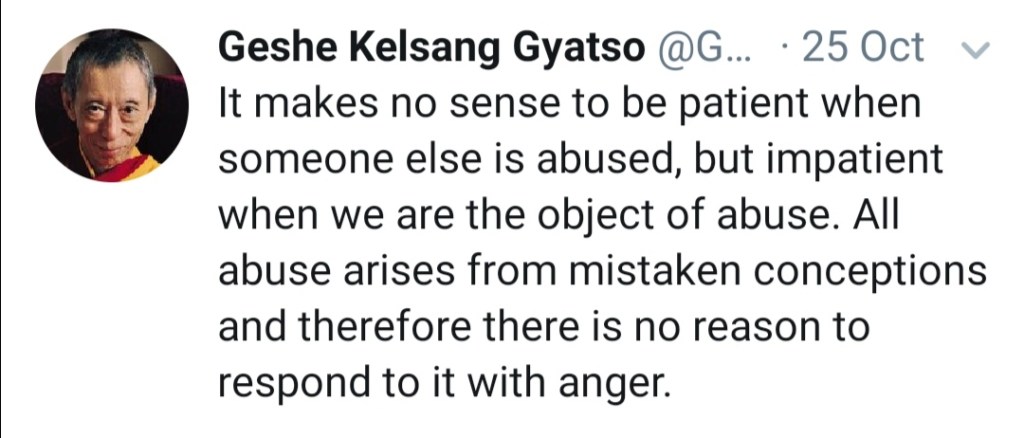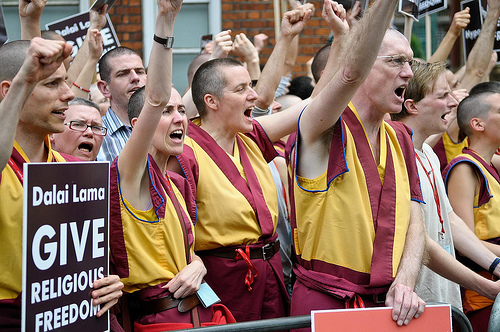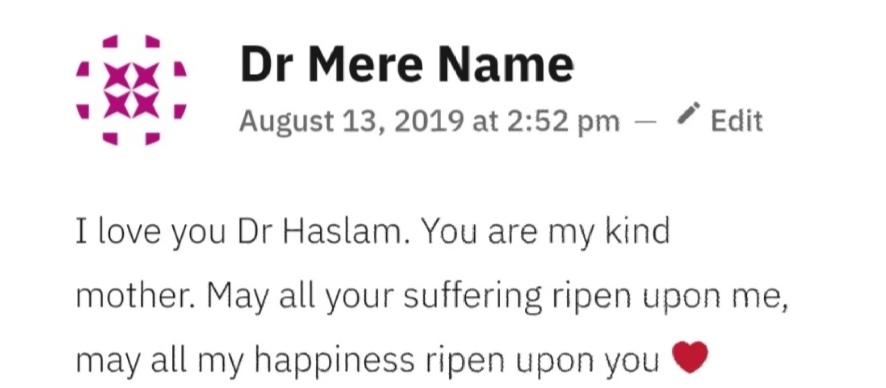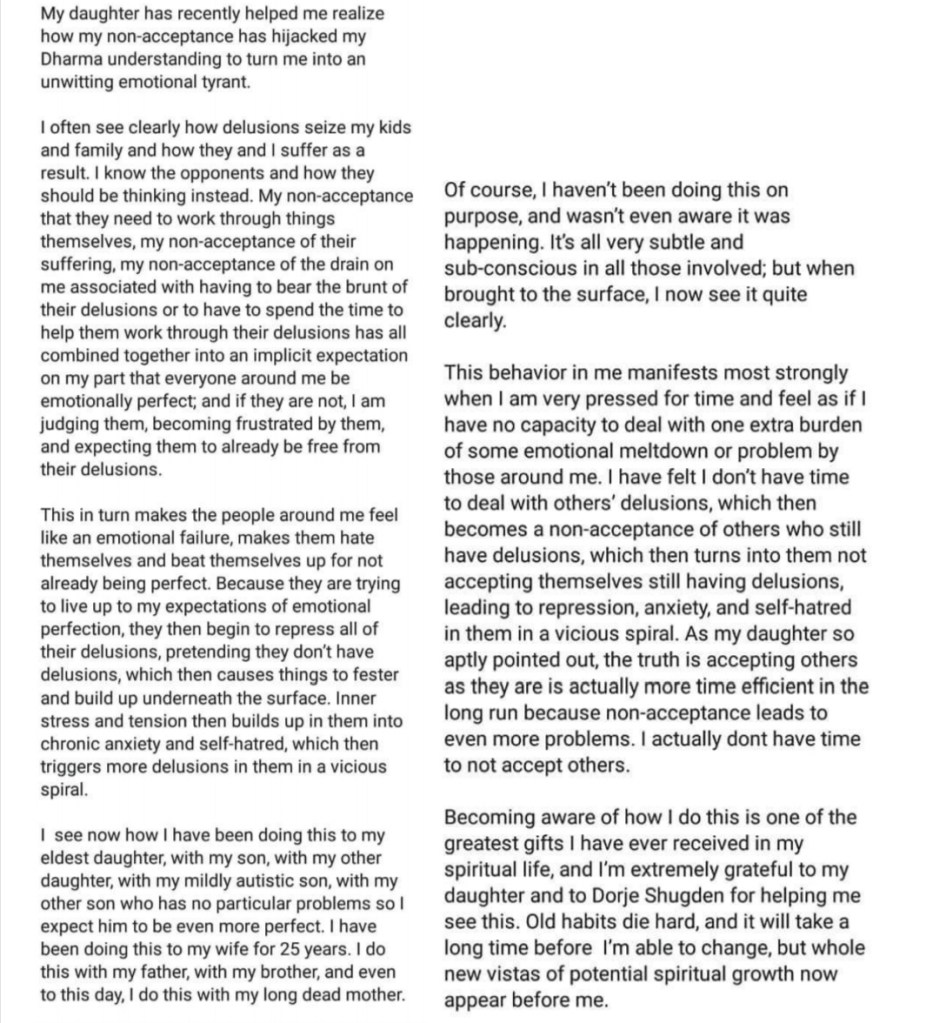‘The follower’s deficiencies are grouped under the umbrella of “the ego,” or a similar idea using different words, which is regarded as a harmful appendage or blockage of the true self, and which must therefore be purified by the leader for the follower to reach her potential‘.
Daniel Shaw, The Relational System of the Traumatizing Narcissist
The NKT recommend ‘holding virtuous objects (thoughts or images) in your mind’ until this becomes more of an automatic habit through practice. NKT classes aim to teach people how to control their attention so that negative thoughts (delusions) cannot enter their experience (thought-stopping), or are ‘transformed’ immediately into more positive or wise ones.

Is it even possible to suppress or transform negative minds?
Findings suggest that the task of suppressing a thought is itself difficult, leading people to hold the thought in consciousness repeatedly even as they try to eliminate it. This means that whilst the NKT teachings suggest that is possible to immediately transform negative ‘minds’ or ‘delusions’ into more positive or wise states of mind so that the person does not experience suffering, there is no evidence that this is actually possible. A thought-stopping therapy technique suggested by Wolpe and Lazarus (1966) for obsessional disorders was found to be no more successful than no intervention at all (Reed, 1985). It is difficult to study this phenomenon however and research in this area continues to depend on the
pre-selection of participants who are already prone to thought suppression.
Potential psychological damage
Even if there was evidence that it is actually possible to immediately transform negative minds into ‘virtuous’ ones, there is abundant evidence that this could cause serious harm in the long run psychologically. There is a paradox in attempting to avoid or eliminate unwanted experiences in that often these attempts lead to an upsurge in the frequency and intensity of the experience the person wishes to avoid (Wenzlaff & Wegner, 2000; Carter & White, 1987; Janis, 1958; 1983; Lazarus, 1983; Horowitz. 1975). Therefore even if it is possible temporarily, the thought is likely to come back stronger than ever later, accompanied by any related unwanted urges, increasing the likelihood of the development of an obsessional disorder.
There is evidence that practicing more ‘balanced’ thinking can help to challenge black and white negative thoughts for some people some of the time. Cognitive Behavioural Therapy (CBT) teaches the practice of spotting your negative thoughts and practicing more balanced alternatives. For example, if a person is thinking ‘I’m stupid’ it can be helpful for them to look for evidence of their strengths, to give them a more balanced view. Or if a person has a catastrophic thought such as ‘I’m going to get stuck in the lift and die’ it can be helpful to practice less catastrophic thinking in order to help calm themselves down. However, they may also need to practice a body-related coping strategy such as deep breathing or grounding themselves in the present moment using their senses. Many people report that when their fight and flight response is triggered, they cannot control their thoughts until they have practiced deep breathing or removed themselves from the triggering situation. This is due to the role that adrenalin and cortisol play in affecting our thinking, memory and bodily reactions.
The danger of valuing absolute truth over relative truth
Unlike the thought challenging methods encouraged within cognitive behavioural therapy, the practice of applying ‘opponents’ for ‘delusions’ in a Buddhist context many would not consider to be more balanced thinking. Focusing on concepts that negate the existence of the self, the value of the self and the emotions of the self could be considered severe emotional invalidation. Would we teach our children that they don’t exist and that their feelings don’t mean anything?
Spiritual bypassing is a term coined by John Welwood to describe a process he saw happening in the Buddhist community he was in, and in himself. He noticed a widespread tendency to use spiritual ideas and practices to avoid facing unresolved emotional issues, psychological wounds, and unfinished developmental tasks. It has also been described as ‘premature transcendence’ (Elliot, 1997; Harris, 1994; Sovatsky, 1998). For example, we might feel jealous because we have a desire for more emotional and physical intimacy, but we might bypass this feeling using absolute truth because we are holding too much fear of intimacy or of trusting another. ‘One might, for example, try to practice nonattachment by dismissing one’s need for love, but this only drives the need underground, so that it often becomes unconsciously acted out in covert and possibly harmful ways instead.’ (Welwood, Tricycle interview).
Spiritual bypassing commonly occurs when people come to believe that ‘human’ issues are not important, and spiritual practice is of a higher realm, with psychological work as a lower realm. According to Kornfield (1993) this is problematic because spirituality is not meant to help a person avoid life problems and dilemmas and instead should assist the person in living an ordinary life complete with the inevitable suffering (West, 2000). Anders (2019a) states that in so called Buddhist groups ‘longing for enlightenment, in the sense of quick relief from suffering rather than through a process of taking individual responsibility and of training, appears to contribute to denying one’s own unconscious aspects, those of the master as well as the resulting group dynamics.’
The stress of self-monitoring and control
Hayes et al (2011) state that ‘the internal drone caused by the clients self-monitoring of emotional causes and effects becomes so chronic that it becomes almost impossible for the client to engage in any activity without almost immediately destroying his or her sense of being present or spontaneous.’ When a person follows a rule that there is a ‘right’ way to be happy they are in a constant struggle. To maintain control the person must be vigilant in recognising early signs that undesirable reactions are occurring. The solution to the struggle for feeling and thinking ‘right’ apparently lies in more vigilance, more scanning of the internal and external environment, and more control. This is likely to lead to the development of an obsessive compulsive difficulty and stress over getting it ‘right’. ‘The clients self-imposed cycle of self-monitoring, evaluation, emotional response, control efforts and further self-monitoring is not a solution to these disorders; rather it is these disorders’ (Hayes et al., 2011).
Trying to avoid emotional pain is also likely to lead to fearful thoughts and behaviours. ‘Trying to avoid painful emotional states ‘is equally destructive to our sense of our life’s direction and to our goal-oriented behaviour. Our behaviour comes to be more under ‘aversive control’ rather than ‘appetitive control’ – more dominated by avoidance and escape than natural attraction. People lose their compass headings altogether because they are too busy monitoring the risk level of each event, interaction, or situation.’ (Hayes et al., 2011). I believe this is indicated below in a video where a monk asserts that we must have a ‘gameplan’ for when our mind becomes negative:
If a painful thought, feeling, memory or sensation does not seem to be functioning as a barrier to helpful actions or goals, there is no reason to see fusion with this thought as an issue. For example, if a victim of domestic violence is fused with the thought ‘I’m not safe’ or ‘this person is dangerous’ and this assists them in taking steps to leave the situation, this is not a thought you would want them to try to transform or defuse from. You would not want the person to consider absolute truths in this moment when they are physically or emotionally in danger.
Many people find it unhelpful to get into a cognitive debate with their thoughts, and some therapies suggest that letting thoughts come and go, without identifying with them as facts can be more helpful. Acceptance and Commitment Therapy (ACT) teaches people skills in being better able to dis-identify with their painful thoughts and feelings, without attempting to get into a struggle with them (defusion). The aim of defusion is not to feel better, nor to get rid of unwanted thoughts however, but to: 1.) reduce influence of unhelpful cognitive processes upon behaviour; 2.) to facilitate being psychologically present & engaged in experience; 3.) to facilitate awareness of language processes, in order to enhance psychological flexibility (Harris, 2007). There are not enough well-controlled studies to conclude that Acceptance and Commitment Therapy is generally more effective than other active treatments across the range of problems examined, but so far the data are promising (Hayes et al., 2006).
Losing your mindfulness skills
Keeping your attention on virtuous objects or ‘minds’ is not mindfulness according to widely used (Western) definitions. According to Jon Kabat-Zinn, ‘Mindfulness means paying attention in a particular way, on purpose, in the present moment, and nonjudgmentally’. This means that there is no effort made to replace undesirable thoughts or emotions with more desirable ones. The NKT advertise themselves as teachers of mindfulness, however beyond the brief breathing meditation at the beginning of the class, they do not teach mindfulness in line with western definitions, they teach thought and emotional control. I would argue that their practices interfere with your ability to be mindful.
The denial of anger
Purifying your mind of anger is considered an essential practice in most Buddhist traditions. Patient acceptance is considered the antidote to anger, with no mention of righteous anger or anger being an appropriate response to having your boundaries or sense of self violated. Gyatso teaches how to avoid retaliating after we are hurt. ‘We may do this by being patient and by learning to think: “he is hurting me only because he is deluded.” Whilst it may be true that someone hurts you because they are struggling with their own emotions and not getting their wishes met, being hypervigilent for signs that you are developing anger and controlling this entirely cognitively I believe is no different to suppression. Gyatso argues there is a difference however. Whilst Gyatso believes it should be possible to transform anger before it even develops in the mind, this idea is not supported in research or in testimonies of ex-members. (How would it be possible to apply an antidote before noticing it had developed? This is like saying we should take an antibiotic before we have even noticed we have developed an infection).
In Buddhism generally, there is no such thing as “righteous” or “justifiable” anger. According to O’Brien (2019) ‘All anger is a fetter to realization. The one exception to seeing anger as a hindrance to realization is found in the extreme mystical branches of Tantric Buddhism, where anger and other passions are used as energy to fuel enlightenment; or in Dzogchen or Mahamudra practice, where all such passions are seen as empty manifestations of the mind’s luminosity. However, these are difficult, esoteric disciplines that are not where most of us practice.’
Focusing on your intention to patiently accept all circumstances is not advisable unless you have a death wish. We must practice defending ourselves from annihilation and abuse. The NKT however teach that abuse is only perceived by our mind:

Despite this idea that there is no such thing as righteous anger, NKT members still reacted like this towards the Dalai Lama, which they still to this day believe is completely justifiable without seeing the contradiction with their own teachings that abuse does not exist outside the mind of the perceiver.

To follow their own teachings NKT members would have to believe that (if the Dalai Lama had indeed violated religious freedom rights):
- That Shugden practitioners had manifested this through their own collective karma
- That any perception of abuse from the dalai lama was created by their own mind and not the Dalai Lama himself
- That the Dalai Lama is actually their kind mother, or Atisha’s cook, teaching them by causing them suffering
- That they should purify this anger and practice compassion for him instead of shouting at him
Many testimonies also reveal that ex-members believe their NKT teachers to be more aggressive and sadistic than average, for example in the first few minutes of this video and in the Facebook post below:

Many report that they witnessed higher than average levels of passive aggression, sarcasm, and many outbursts of rage that eventually were triggered. Whilst Gyatso thinks it’s possible to transform anger before it develops, NKT practitioners certainly can’t seem to practice this when they speak to critics of their guru. (Being in a state of fervor makes us hyper-sensitive to criticism of the guru and teachings). Some trolling I have received that I interpret as passive aggressive is below.




Some seem to understand that this is wrong, as they use fake identities, whilst others seem oblivious that they are being passive aggressive and still use their full names.
Shields has stated that “as a culture we are ambivalent about emotion” (1987, p. 231). This cultural ambivalence is reflected in many common expressions that subtly denigrate emotion and emotional display. Researchers (Murray, 1985; Tavris, 1984) have pointed out that expression of negative emotions such as anger present special problems for individuals because the expression of these emotions may hold important ramifications for the social group. English people in particular, known for valuing politeness, often hold repressed anger and fear of conflict. I believe Buddhist teachings which suggest it is unskilful and unhealthy to ever feel angry are particularly dangerous for English people.
Ex-members report invalidating their own anger, and then experiencing guilt and shame due to eventual outbursts. Such outbursts of rage could perhaps have been prevented if people had more tools for channelling and working with this emotion (and if they didn’t all live together in a pressure cooker environment, overwork, underexercise, etc). Sadly members tend to assume they just arent very good at the practice, believing they are spiritually inadequate instead of abandoning the practice altogether. According to Anders (2019) Buddhist teachings are often oversimplified by Western teachers with a hidden agenda. I believe this teaching is used to keep people from whistleblowing abuse or acting to protect themselves from exploitation by the NKT. My own experience of trying to transform anger meant that I reinforced my own tendency to patiently accept bad behaviour in others instead of setting firmer boundaries. I once accidentally enabled serious psychological abuse from an NKT teacher towards his mother which left her in tears. I was too busy focusing on trying to have patience and remember he was faultless to realise he was committing an act of abuse (that indicated a serious personality difficulty, and not just a moment of anger).
The potential damage to your physical health
Many of the assumptions about the advantages of emotional expression are based on the well-documented inverse relation between emotional expression and autonomic reactivity (Buck, 1984; Hokanson & Burgess, 1962; Hokanson & Shetler, 1961; Jones, 1935). Typically, the inhibition of emotional expression has been associated with an increase in autonomic activity (Pennebaker, 1985). Chronic autonomic arousal, in turn, is associated with development of psychosomatic disease. ‘Bottled up’ emotions have been blamed by many for symptomatology, both psychological and physical (e.g. Freud 1917/1977; Fridlund, Newman & Gibson, 1984; Pelletier, 1985). Styles of emotional expression have been brought up in relation to several physical illnesses, including cancer (Cox & McCay, 1982; Derogatis, Abeloff, & Melisaratos, 1979; Greer & Morris, 1975; Jensen, 1987), coronary heart disease (Friedman & Booth-Kewley, 1987; Friedman, Hall, & Harris, 1985; Gentry, 1985; Goldstein, Edelberg, Meier, & Davis, 1988), and other diseases (Beutler, Engle, Oro-Beutler, Daldrup, & Meredith, 1986; Pelletier, 1985; Udelman & Udelman, 1981). Cox and McCay (1982) concluded that the strongest psychosocial predictor of cancer is an antiemotional attitude, particularly an inability to express negative emotion. Studies have also supported the idea that unexpressed hostility is associated with coronary heart disease (Gildea, 1949, and Cady et al, 1961, cited in Friedman, Harris, & Hall, 1984). However it is not possible to state that emotional expression is always healthier than repression, and so researchers have studied a construct called ‘ambivalence’ towards emotional expression, to assist them in discriminating between those who are relaxed quiet people and those who are repressed, tense inhibitors. Pennebaker (1985) suggests that lack of expression per se may not be pathogenic. Rather, according to Pennebaker, lack of emotional expression coupled with the desire to express emotion is the damaging combination. There is evidence that thought suppression and thought control exacerbates trauma symptoms. Studies by Pennebaker (Pennebaker & Hoover, 1986; Pennebaker, Hughes & O’Heeron, 1987) have found that individuals who inhibit their desire to confide in others about traumatic life events are at an increased risk for the development of later health problems.
The damage done to relationships with outsiders
Not only does applying opponents affect the individual’s relationship with their emotions, but has also been observed to have a serious impact on their ability to understand and validate the emotions of their family and friends outside of the NKT. This is indicated in the post below, by a practitioner who believes he understands how his daughter ‘should’ be thinking:

The above indicates in my opinion how believing that you know the answers to peoples emotional problems can have a detrimental effect on your ability to understand, validate and accept their emotions. You are at risk of invalidating them, speaking as if you know the answer, which is likely to irritate people and lead them to view you as more narcissistic. Sadly, the practitioner who posted the above believes that the answer is to refine his practice whilst staying in the NKT, even though applying opponents for ‘minds’ or ‘delusions’ is one of the central premises of the teachings.
Despite the above, the NKT believe that they hold the answers for ensuring healthy family relationships:

Would we want to teach our children that they don’t exist and that their painful feelings don’t mean anything? Would we want to hold the idea that our child does not exist inherently in our minds at all times? Would we want to teach them not to defend themselves if they were attacked or abused, but instead to patiently accept annihilation and to see their abuser as having no faults? These practices will not lead to healthy family relationships, they are likely to lead to emotional neglect, invalidation and disorganised attachment.